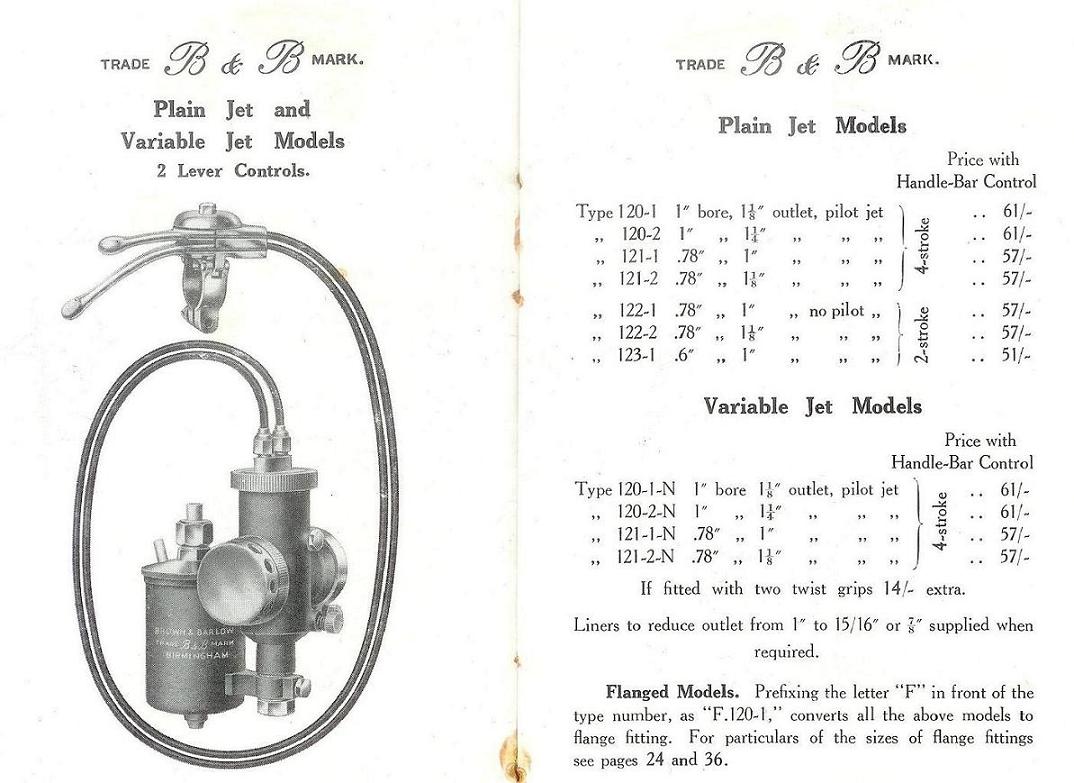
The B&B Plain Jet carburetor is probably one of the most common types fitted to early vintage machines of smaller capacity.
Owning a vintage motorcycle has its enjoyment but also has its headaches, especially when it comes to maintenance. Long gone are original handbooks and for the handbooks that do exist there is very limited information in them. Motorcycle manufacturers published only the basics concerned directly with what they made and for outsourced items like magnetos, generators and carburetors the repairer would have to consult that particular suppliers handbook. That should not really be a problem with the amount of AMAL, AMAC, B&B etc carbs out there fitted to vintage bikes however we are now 85 years further on and books never survive that well compared to the machines themselves. For the books that have survived they are becoming fragile and at the risk of damage or loss owners are loath to lend them out.
To this end we at Barnstormers have found some of these manuals in the ‘magic cupboard’ and after many late nights studying the contents have put together some guidelines on how to better understand the basics of the Plain Jet carburettor (the Variable Jet carburettor is the same except it has a main jet needle which is more akin to modern day AMALs).
Obtaining that last bit of performance from their machines (remember every 1/8th hp counts on those long hills – just ask Knobby) riders need to understand that besides the carburettor any of the following can upset the general running of an engine and should be confident that they are in correct adjustment –
1) Ignition Timing – the points should be adjusted correctly to 0.012″ and timed correctly to full advance BTDC (Before Top Dead Centre)
2) Valve Clearances – Tappets should be set to correct manufacturers specification (see Tappet Adjustment in Technical section on this site)
3) Check to ensure that there are no air leaks between the carburettor and cylinder ( most vintage machines have screw in manifolds or stubs which are prone to air leaks around the threads.)
4) Worn inlet valve guides – causes leaning out of the fuel mixture resulting in erratic idling and can cause overheating.
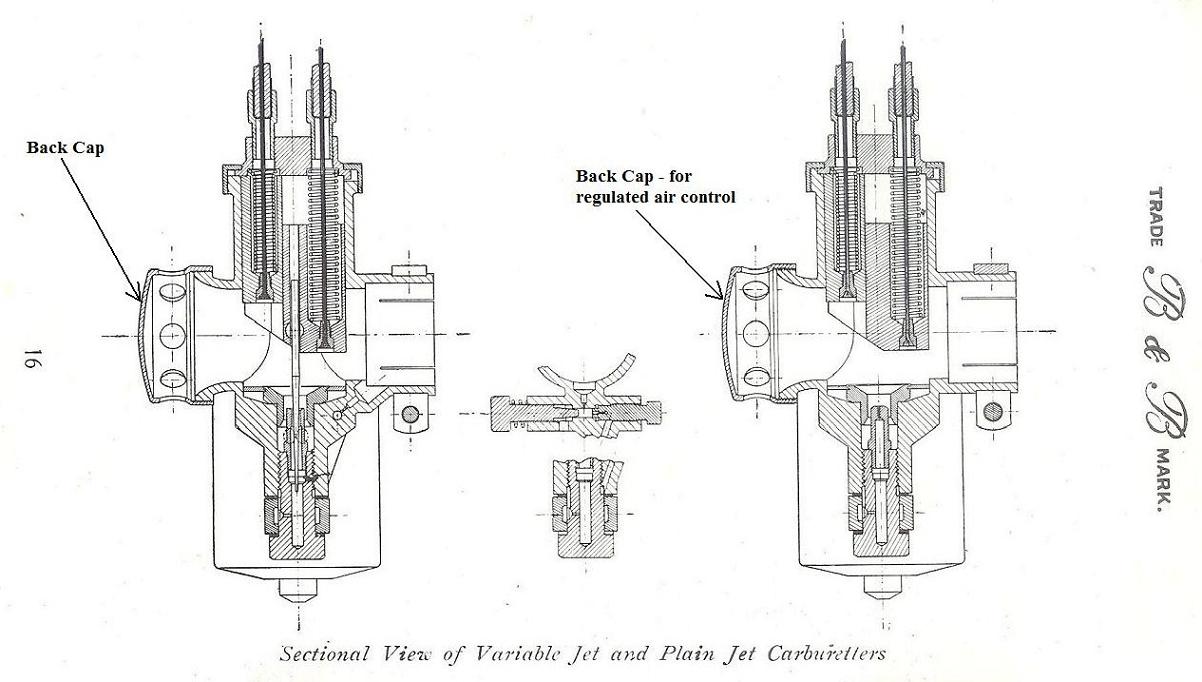
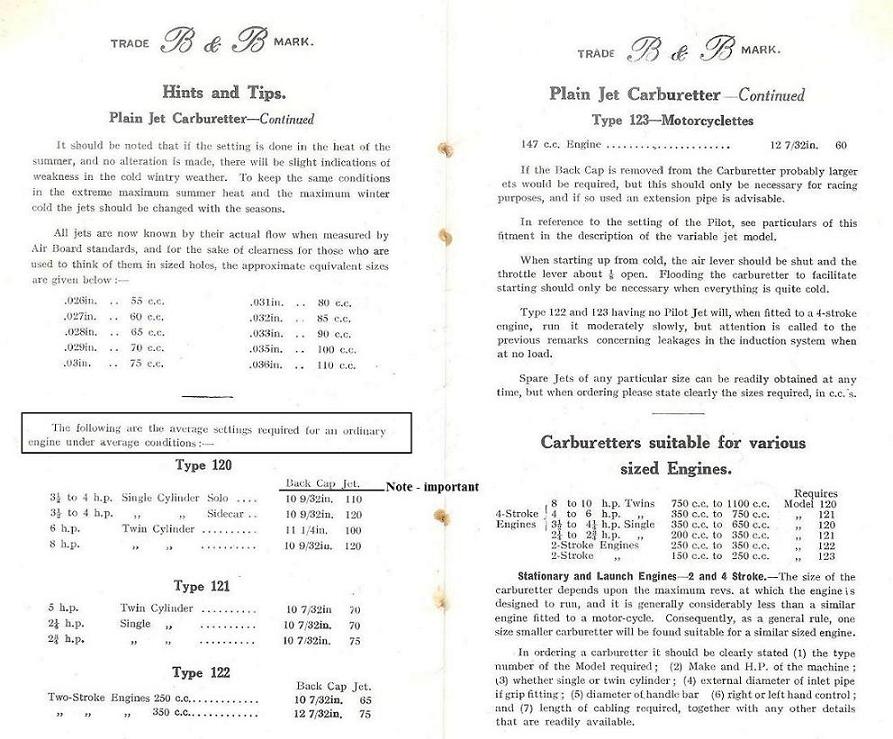
Hints and Tips.
The main areas of tuning and adjustment of the B&B carburettor are –
1) Main Jet – Different than the later types of carburettors this jet is screwed into the float bowl retaining bolt. Jet size is measured in cc’s. Be aware that jets do wear, or may be drilled out so the number on the jet doesn’t match the hole size. Aperture needs to be checked that it is of the correct size to jet number and for the machine size (Refer to the Jet Equivalent Chart for sizing and Hints and Tips Page for approximate size). Effects engine running 1/2 to full throttle
2) Back Cap – This is the small cap with the drilled holes on the carb intake, effects mid range power and limits top end revs. If removed it has to be replaced with a velocity tube and bigger main jet. Refer to Hints and Tips Page for nominal sizing. Effects engine running ¼ to full throttle. If the engine is running excessively rich under normal riding conditions temporarily remove this cap and see if the situation changes.
3) Float Height – Effects engine running from idle to ½ throttle. This is one of the most important and yet ignored adjustments that ensures the correct running of the engine. Too low a fuel level and the motorcycle can be hard to start, and can run lean at full throttle. Too high a fuel level and the engine will run too rich up to ½ throttle effecting low speed exceleration. It can also cause unnecessary flooding of the main carburettor body wasting fuel and creating a possible fire risk – especially if the magneto is situated underneath.
Measuring the Fuel Level – (See Float Bowl Schematic). Make sure the motorcycle is on level ground (if on the rear stand you may have to block up the front wheel to keep the bike at an equal height). Unbolt the float bowl, and leaving the retaining nut in position measure distance ‘E’. Transfer this measurement to the outside of the main carburettor body measuring up from the bottom and mark with a fine tip felt pen. This is the equivalent outside position of the top of the main jet when the float bowl is bolted up. Measure down 0.2″ or 5mm (distance ‘A’) and mark, this is the correct fuel level. Bolt up the float bowl to the carburettor. Undo bolt ‘D’ and screw in a piece of soft copper tube 25mm long, seal around with silicon. Connect a piece of clear plastic pipe to the tube and run it up the side of the carb body next to the reference marks. Turn on the fuel tap and observe the fuel level in the pipe. It should be equal to the bottom reference line – this being the ‘Fuel Level’. If the level is higher or lower it will require adjusting.
Adjusting the Fuel Level – If anything the level will be too high. This is due to wear on the float needle and seat in the float bowl causing the float to sit higher inside its chamber. If the level is up to 2mm higher you may be able to get away with putting a lightweight spacer (fibre is good) under the shoulder on the needle, on top of the float at point ‘C’. Beware – Any heavier spacer will just weigh the float down and require more fuel to lift the float pushing the fuel level up. If you have the B&B float that clips into a groove on the needle then you may be able to regroove the needle a couple of mm lower from original.
If the fuel level is any higher the float needle and seat may be worn to the point of having to be replaced. This will require the machining up of a new needle. If the fuel level is too low then there is the possibility that the needle is the incorrect one and will need modifying or replacing (check Float Needle Chart for correct B&B specifications). Note – there is a belief that by putting more fibre spacers at point ‘B’ will alter the fuel level. For later carburettors this is correct but for this carb with the jet in the float bowl retaining bolt this is not the case.
4) Pilot Air Screw – Effects engine running from idle to ¼ throttle. Screwing the pilot adjusting screw OUTWARDS leans the mixture out. To adjust lightly seat the pilot air screw fully in and then turn out 1 full turn. Start the engine and set the throttle lever so that the engine is running at a fast idle. Turn the mixture screw out slowly witnessing the engine revs rising. Reset the throttle lever to bring the idle speed down. Continue to screw the mixture screw out slowly until the engine starts to falter. At this point screw the mixture screw back in 1/8 turn. The pilot mixture is now correctly set.
5) Throttle Cutaway – Effects engine running from 1/3 to 2/3 throttle. Not really adjustable as requires the complete changing of the throttle slide and spares replacements would be hard to locate unless especially made.
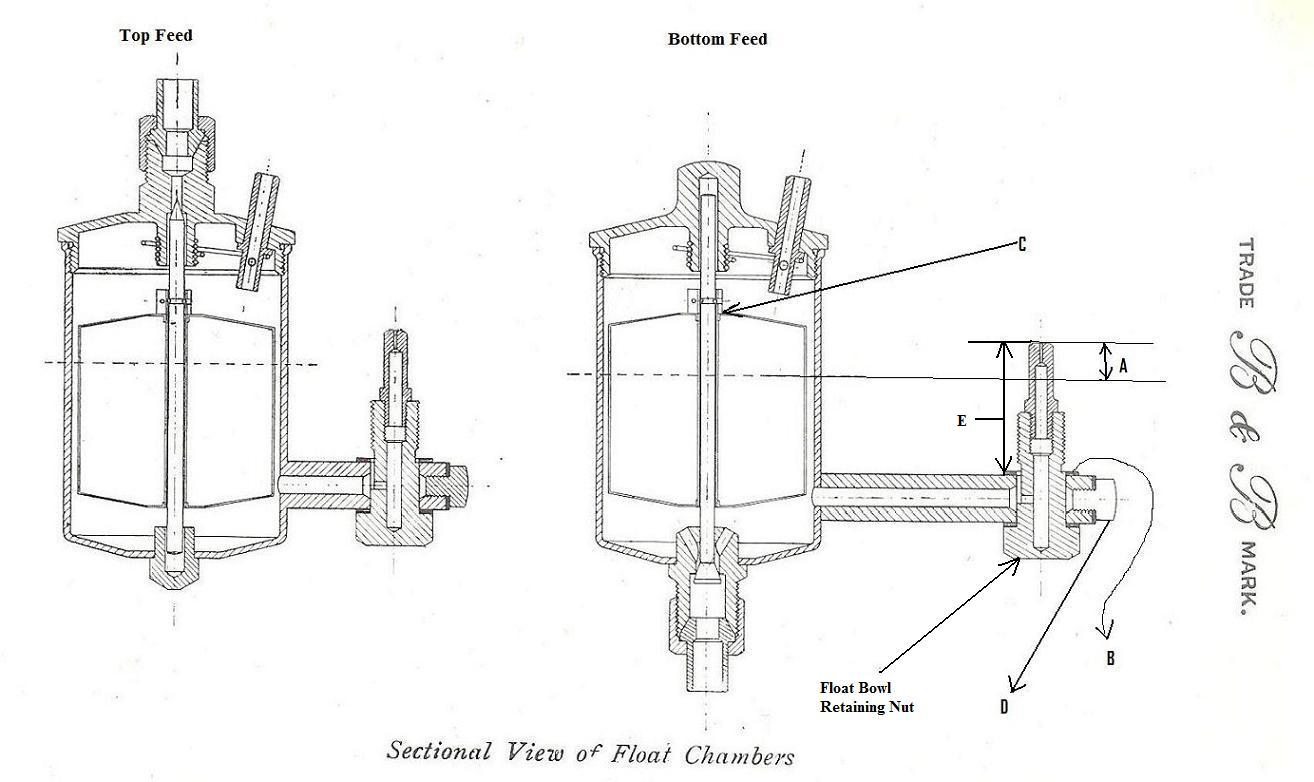
Remember – not everything is as it seems even when it comes to carbs, especially carbs that have survived 80 years. Parts wear, parts get swapped, and parts get modified. So beware of –
Carburettor bodies that have been plated as small air bleed holes crucial to correct operation can be covered over.
Incorrect float needles and main jet needles (on variable jet carbs).
Incorrect main jets being used.
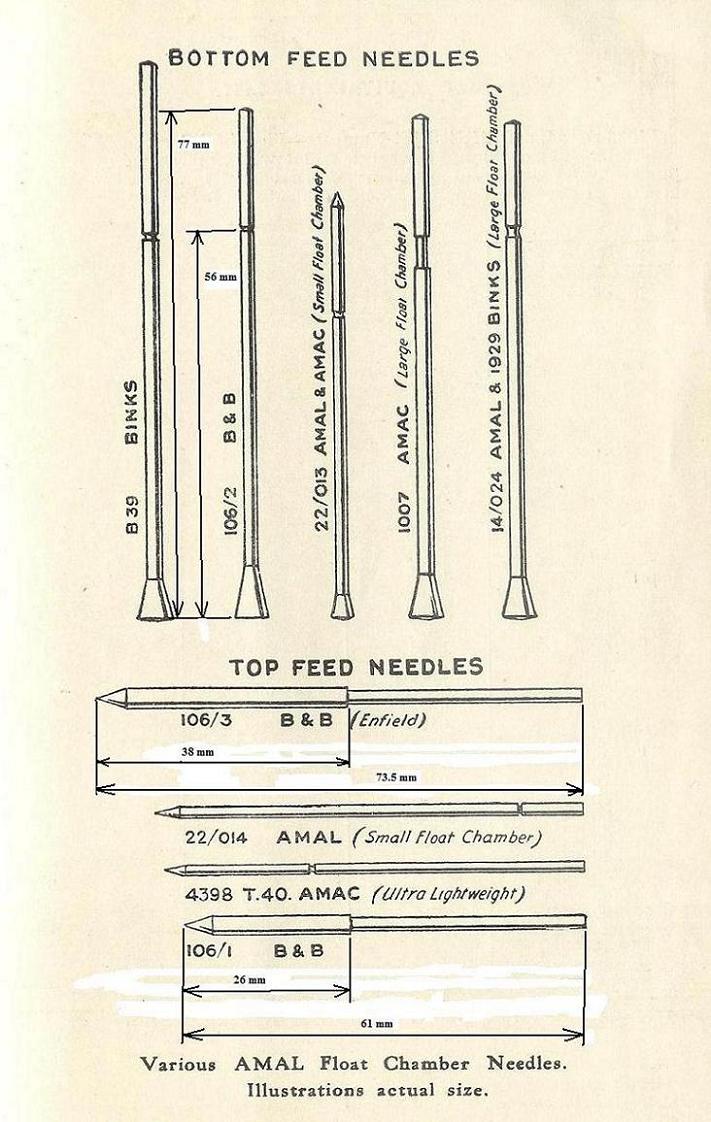
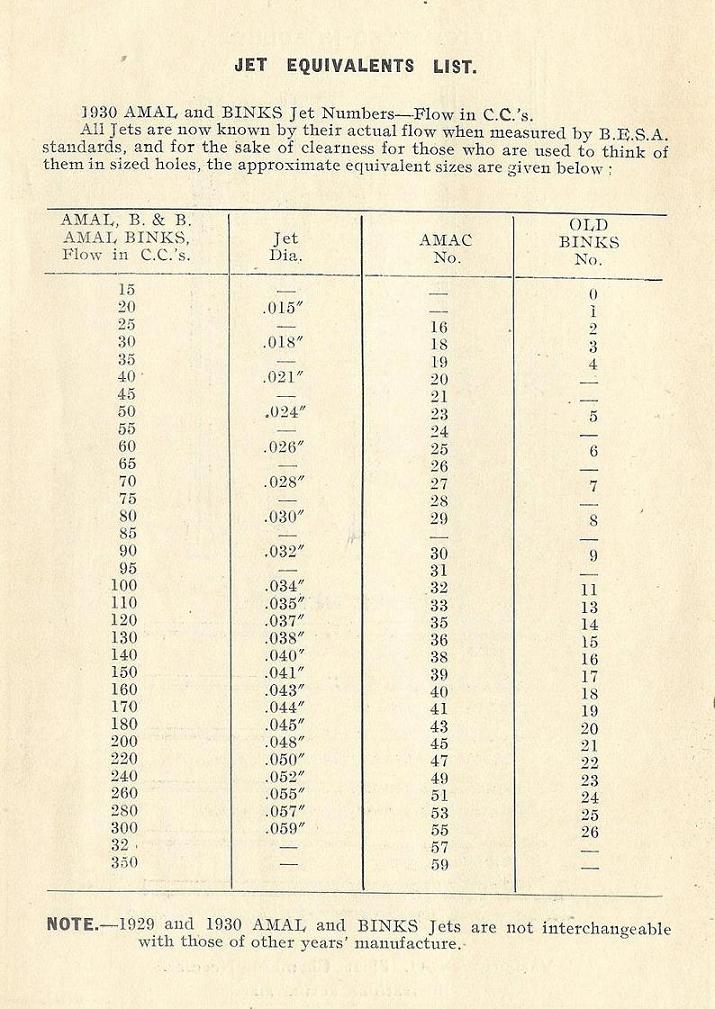
Carburettor Jet Equivalents Chart.
This is an “approxiamate equivalents” chart as there is no exact equivalents given the vast difference in jets. Old Binks and AMAC carburetors had their own type of jet numbering which meant nothing except to themslves, whereas later on AMAL, Binks and B&B jets were sized in flow of cc’s. This is used right up to modern times for most manufacturers.
The Barnstormer Boys have spied some other 1920s carburettor manuals way back in the shadows of the ‘magic cupboard’ and when they have better understood them after completing their advanced reading course (there are a lot of pictures as well).
